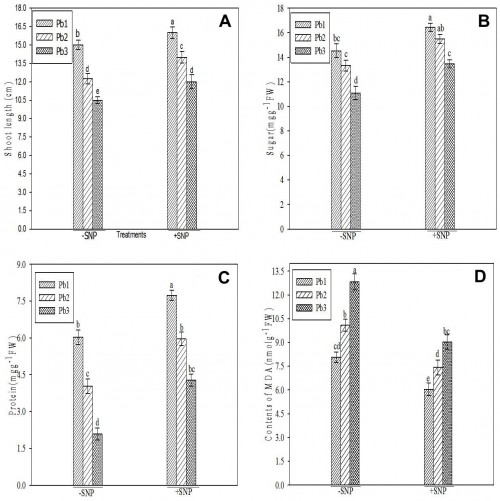Tropical Plant Research
An International Journal by Society for Tropical Plant Research
2017, VOLUME 4 ISSUE 2Pages: 225-234
Oxidative stress induced by lead in Vigna radiata L. seedling attenuated by exogenous nitric oxide
Himani Singh, N. B. Singh*, Ajey Singh, Imtiyaz Hussain and Vijaya Yadav
*Plant Physiology Laboratory, Department of Botany, University of Allahabad, Allahabad-211002, India
Abstract:
The present study deals with the effectiveness of nitric oxide (NO) on some biophysical and biochemical variables in Vigna radiata subjected to lead (Pb) toxicity. Pb adversely affected seedling growth and biochemical parameters of the test crop. The seedlings were grown in soil supplemented with graded concentrations of Pb. Pb toxicity caused a marked decrease in growth. Seedlings growth reduced maximum at the highest concentrations of Pb. The effect of Pb on seedlings was mitigated by NO donor sodium nitroprusside (SNP). Pre-treatment of seeds with SNP caused amelioration of detrimental effects of heavy metal stress on growth. The oxidative stress induced by Pb elevated malondialdehyde (MDA) content in the seedlings. Nitric oxide decreased MDA content in Pb treated seedlings. Exposure of seedlings to Pb enhanced antioxidant enzyme activities of the seedlings, but exogenous SNP decreased the activities of superoxide dismutase (SOD), catalase (CAT) and peroxidase (POX) in single (SNP) and SNP combined with Pb (Pb+SNP) treatment. Pb induced oxidative stress by enhancing the reactive oxygen species. SNP demonstrated a positive role against Pb toxicity which was evident from decreased activities of antioxidant enzymes. The SNP treatment enhanced plant tolerance against Pb toxicity.

Fig.: Effect of NO in seedlings of Vigna radiata under lead stress: A, Shoot length; B, Sugar; C, Protein; D, Lipid peroxidation.
| 0 | 1 | 2 | 5 | 5 | 7 | 6 | 5 |


